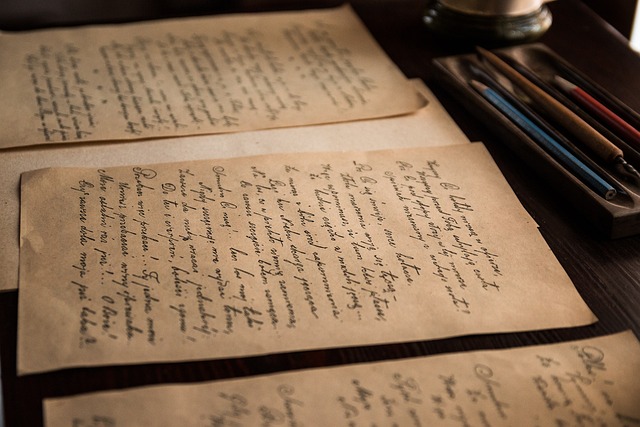Have you ever found yourself captivated by the beauty and mystery of ancient scripts? From the awe-inspiring hieroglyphics of the Egyptians to the intricate calligraphy of medieval monks, these ancient forms of writing transport us back in time, illuminating ancient civilizations and their incredible stories. Today, we’re diving into the intriguing world of Hebrew block letters – a script that has evolved over thousands of years and continues to be cherished by Jewish communities worldwide. Whether you’re a language enthusiast, a history buff, or simply curious about exploring different writing systems, this article is your gateway into understanding and mastering the art of Hebrew block letters. Get ready to unlock the secrets of this mesmerizing script, as we embark on a journey back in time to ancient Israel.
Contents
- Understanding the Basics: Introduction to Hebrew Block Letters
- Mastering Letter Formation: Step-by-Step Guide to Writing Hebrew Block Letters
- Exploring Ancient Hebrew Script: Historical Significance and Evolution
- Embarking on Calligraphy: Techniques to Enhance Your Hebrew Block Letter Writing
- Enhancing Aesthetics: Adding Personal Style to Your Hebrew Block Letters
- Avoiding Common Mistakes: Tips to Perfect Your Hebrew Block Letter Writing
- Honoring Tradition: Preserving Ancient Hebrew Script in Modern Times
- Frequently Asked Questions
- In Conclusion
Understanding the Basics: Introduction to Hebrew Block Letters
Hebrew block letters, also known as square script, are a fundamental aspect of the Hebrew language and its written form. They have a distinctive appearance with each letter being composed of straight lines, right angles, and sharp corners. Understanding these block letters is crucial for anyone seeking to read and write in Hebrew, as they form the basis of the script used in a variety of contexts such as religious texts, ancient manuscripts, and modern Hebrew publications.
One of the main features of Hebrew block letters is their uniformity in size and shape. Unlike other alphabets that may vary in width and height, Hebrew block letters are designed to fit into a square grid, creating a visually balanced and harmonious text. This consistency aids in legibility and enhances the overall aesthetic appeal of written Hebrew.
Learning Hebrew block letters involves familiarizing oneself with the basic forms of each letter and understanding their corresponding sounds. Some notable characteristics of these letters include:
– Each letter is formed entirely with straight lines, resulting in a clean and bold appearance.
– The majority of Hebrew block letters are written using capital letters, with no distinction between uppercase and lowercase.
– Many letters share similar shapes, distinguished only by small modifications or the addition of dots and lines.
By acquiring proficiency in Hebrew block letters, you will gain the necessary foundation to delve deeper into the intricacies of the Hebrew language, uncover its rich history, and explore its diverse literature. Mastery of these letters will open up a world of opportunities for you to engage with Hebrew texts, whether you are studying religious scriptures, deciphering ancient inscriptions, or simply enjoying modern Hebrew literature. So, grab a pen and paper, open your mind to this unique script, and let the beauty of Hebrew block letters unfold before you.
Mastering Letter Formation: Step-by-Step Guide to Writing Hebrew Block Letters
Learning to write Hebrew block letters can be an exciting journey that allows you to connect with the rich traditions and culture of Hebrew language. Whether you’re a beginner or looking to refine your skills, this step-by-step guide will help you master the art of letter formation, paving the way for beautiful and legible Hebrew handwriting.
To start your letter formation journey, here are a few key steps to keep in mind:
- Understand the basics: Before diving into writing Hebrew block letters, familiarize yourself with the alphabet and their corresponding sounds. This knowledge will be crucial in creating accurate and meaningful words.
- Access the right resources: Obtain a Hebrew block letter chart or printable practice sheets, easily available online or in language learning books, to guide you through each letter’s structure. Repetition is key, so don’t hesitate to print multiple copies.
- Perfect your strokes: Hebrew block letters are formed using a combination of straight lines and curves, making it essential to practice stroke placement and direction. Pay close attention to areas where lines intersect and ensure that your letter proportions are consistent.
Remember, practice makes perfect. Dedicate a few minutes each day to practicing letter formation, gradually progressing from individual letters to words. Experiment with different writing instruments to discover which one feels most comfortable for you. With time and patience, you’ll soon find yourself effortlessly crafting Hebrew block letters that truly stand out.
Exploring Ancient Hebrew Script: Historical Significance and Evolution
The ancient Hebrew script is an invaluable artifact of human civilization, providing us with profound insights into the historical significance and evolution of the Hebrew language. As we delve into the fascinating world of this ancient script, we discover its remarkable journey through time and its enduring impact on various aspects of Hebrew culture and identity.
One of the most intriguing aspects of the ancient Hebrew script is its evolution over centuries, reflecting the ever-changing nature of the Hebrew language itself. From its earliest form, known as Paleo-Hebrew, to the more familiar square script used in modern Hebrew, we witness a gradual transformation that spans thousands of years. Each variation tells a story, shedding light on the cultural, religious, and linguistic developments that shaped Hebrew civilization.
In addition to its historical significance, the ancient Hebrew script holds great cultural importance. It is intricately entwined with religious practices, as it was used to write important religious texts such as the Torah and other sacred scriptures. The visual aesthetics of the script itself carry deep symbolic meanings, resonating with the spiritual beliefs and values of the Hebrew people.
Exploring the ancient Hebrew script not only allows us to appreciate its artistic beauty but also unveils a rich tapestry of history, language, and spirituality. From its humble beginnings to its present-day usage, this script serves as a poignant reminder of the enduring legacy of the Hebrew people and their remarkable journey through time.
Embarking on Calligraphy: Techniques to Enhance Your Hebrew Block Letter Writing
Calligraphy is an art form that has captivated individuals for centuries, serving as a creative outlet and a means of expression. If you’re looking to enhance your Hebrew block letter writing skills, we have some techniques that will elevate your calligraphy to new heights.
1. Master the basics: Before diving into more complex techniques, it’s crucial to have a solid foundation. Practice the basic Hebrew block letter forms and strokes, ensuring consistency and accuracy. This will set the stage for more advanced techniques.
2. Focus on spacing and alignment: Pay close attention to the spacing between each letter and the alignment of your words. A well-spaced and neatly aligned piece of calligraphy is visually pleasing and easier to read.
Enhancing Aesthetics: Adding Personal Style to Your Hebrew Block Letters
When it comes to Hebrew calligraphy, the possibilities for adding your personal touch are endless. With a few simple techniques, you can elevate the aesthetics of block letters and infuse them with your unique style. Here are some tips to help you enhance the visual appeal of your Hebrew script:
1. Experiment with Different Font Styles:
Hebrew calligraphy offers a diverse range of fonts and lettering styles, each with its own charm and character. Take the time to explore various Hebrew fonts, such as Ashuri, Rashi, or even contemporary styles like Stahls’ Hebrew Block, to find the one that resonates with your personal taste. This versatility allows you to add a distinctive touch to your block letters and create an aesthetic that speaks to you.
2. Play with Decorative Embellishments:
To further refine your Hebrew block letters, consider incorporating decorative embellishments. Experiment with swirls, flourishes, or unique serifs to add flair and elegance to your script. You can also use decorative elements like filigree, stars of David, or meaningful symbols to infuse deeper symbolism into your lettering. Aim to strike the right balance between embellishment and legibility, as the goal is to enhance aesthetics while maintaining clear, distinct letterforms.
Avoiding Common Mistakes: Tips to Perfect Your Hebrew Block Letter Writing
Writing in Hebrew block letters can be quite challenging, but with a few helpful tips, you can perfect your skills and avoid common mistakes. Paying attention to the following techniques and guidelines will not only enhance the legibility of your Hebrew writing but also make it visually pleasing.
1. **Maintain consistency**: Consistency is key when it comes to creating Hebrew block letters. Ensure that each letter is proportionate in size, width, and height. This uniformity will provide a neat and well-structured appearance to your writing.
2. **Master the strokes**: Hebrew block letters consist of unique strokes, such as the “k’tav Ashuri” style. Take time to familiarize yourself with the proper strokes for each letter, paying special attention to their starting and ending points. This will help you achieve precise letter formations.
3. **Watch your spacing**: Proper spacing between letters and words is crucial for readability. Be mindful of the spacing and maintain a consistent gap between each character. This will also prevent your writing from appearing cluttered.
4. **Use guidelines**: To ensure your Hebrew block letters are aligned correctly, consider using guidelines. These can either be purchased or created digitally using available templates or ruler tools. Guidelines provide a helpful structure and prevent your letters from slanting or appearing uneven.
5. **Practice, practice, practice**: Like any new skill, practicing regularly is essential for mastering Hebrew block letter writing. Allocate time each day to practice forming letters and words. This will help train your muscle memory and improve your overall writing speed and accuracy.
By implementing these tips and techniques, you’ll be well on your way to perfecting the art of Hebrew block letter writing. Remember, practice makes perfect, so don’t be discouraged if it takes time to achieve the desired results. With consistent effort and dedication, you’ll soon become a proficient writer of Hebrew block letters.
Honoring Tradition: Preserving Ancient Hebrew Script in Modern Times
One of the most captivating aspects of the Hebrew language is its ancient script, which holds a rich history dating back thousands of years. Despite the modernization of writing systems, there is a dedicated community of language enthusiasts, scholars, and calligraphers tirelessly working to preserve this ancient script in today’s world. Their efforts go beyond mere nostalgia; they are driven by a deep respect for the cultural and linguistic heritage embodied by the Hebrew script.
Preserving the ancient Hebrew script involves meticulous attention to detail, as every stroke and curve of the letters carries significance. These dedicated individuals employ various techniques to honor tradition, such as:
- Calligraphy Workshops: These interactive workshops provide a hands-on experience for participants to learn the art of Hebrew calligraphy. Attendees can explore the complexities of letter formation, spacing, and decorative elements, ensuring the script is passed down accurately and with finesse.
- Historical Research: Language historians and scholars delve deep into the annals of history to uncover ancient manuscripts, inscriptions, and documents written in Hebrew. Their meticulous examination and analysis help shed light on the subtle nuances of the script, providing valuable insights into its evolution across different eras.
- Revitalizing Communities: Language preservation efforts extend beyond academics and professionals. Community events, gatherings, and cultural festivals play a crucial role in fostering a sense of identity and pride among Hebrew speakers. These celebrations serve as platforms for showcasing the ancient script, ensuring that it remains a vibrant part of contemporary culture.
Thanks to the dedication and unwavering commitment of individuals and organizations around the world, the ancient Hebrew script continues to thrive and inspire new generations. By honoring tradition and preserving this treasure from the past, we can ensure that the essence of Hebrew language and culture remains intact for years to come.
Frequently Asked Questions
Q: What are Hebrew block letters?
A: Hebrew block letters refer to a style of writing the Hebrew alphabet that is characterized by bold, angular, and square-shaped letters. It is an ancient script form that was used in Hebrew manuscripts, inscriptions, and documents.
Q: Why should I learn to write Hebrew block letters?
A: Learning to write Hebrew block letters allows you to engage with the ancient Hebrew script form, connecting you to a rich cultural and historical heritage. It can deepen your understanding of Hebrew, enable you to read ancient manuscripts, and enhance your Hebrew calligraphy skills.
Q: What materials do I need to write Hebrew block letters?
A: To write Hebrew block letters, you will need a pen or pencil, paper or a practice workbook, and a ruler to help maintain clean, straight lines. You may also consider using tracing paper to practice letter forms.
Q: How do I start learning to write Hebrew block letters?
A: Begin by familiarizing yourself with the Hebrew alphabet, its individual letter shapes, and their corresponding sounds. Once you have a basic understanding of the letters, you can start practicing block letter formation by following step-by-step guides or working with a calligraphy instructor.
Q: Are there any specific techniques for writing Hebrew block letters?
A: Yes, some key techniques for writing Hebrew block letters include maintaining uniform letter size, keeping straight lines in the letterforms, and ensuring consistent spacing between letters. Focus on precise pen or pencil strokes to achieve clean and crisp letter shapes.
Q: Are there any recommended resources to help me learn Hebrew block letters?
A: Yes, there are plenty of resources available to assist you in learning Hebrew block letters. Online tutorials, exercises, and YouTube videos provide step-by-step instructions. Additionally, books and practice workbooks dedicated to Hebrew calligraphy can be found in bookstores and libraries.
Q: How much time should I dedicate to practicing Hebrew block letters?
A: The time you dedicate to practicing Hebrew block letters depends on your personal goals and commitment. Regular practice, even if it’s just a few minutes each day, can greatly improve your skills over time. Consistency is key, so find a practice routine that works for you.
Q: Can I use Hebrew block letters in modern contexts?
A: While Hebrew block letters are primarily used to write in ancient script forms, they can still be utilized in specific modern contexts. Some people incorporate block lettering in art, design, or calligraphy projects to add a unique touch or pay homage to the ancient Hebrew script.
Q: Are there any common mistakes to avoid when writing Hebrew block letters?
A: Yes, some common mistakes to avoid when writing Hebrew block letters include uneven letter sizing, crooked lines, and inconsistent spacing. It’s important to stay focused and patient while practicing, ensuring each letter is as accurate as possible.
Q: How can I further enhance my Hebrew calligraphy skills beyond block letters?
A: Once you have a solid foundation in Hebrew block letters, you can explore more advanced calligraphy styles. These styles include cursive Hebrew, italicized Hebrew, or even experimenting with decorative embellishments. Advanced calligraphy workshops or online courses can help you refine and expand your skills.
In Conclusion
In conclusion, learning Hebrew block letters opens up a gateway to understanding ancient texts and connecting with a rich cultural heritage. Start practicing today and unlock a whole new world of language and history!








